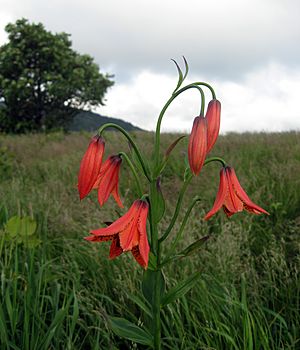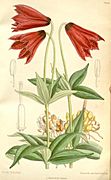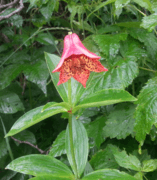Gray's lily facts for kids
Quick facts for kids Gray's lily |
|
|---|---|
 |
|
| Conservation status | |
| Scientific classification | |
| Genus: |
Lilium
|
| Species: |
grayi
|
| Synonyms | |
|
|
Lilium grayi is a beautiful wild flower also known as Gray's lily, Orange bell lily, or Roan lily. This plant grows year after year, making it a perennial. You can find it only in the eastern parts of the United States, specifically in North Carolina, Virginia, and Tennessee. It likes to grow in damp, acidic soil in the Appalachian Mountains. Look for it in high-up meadows, bogs, and wet areas. This special lily was brought to the Royal Botanic Gardens, Kew in England in 1890.
Contents
Discovering Gray's Lily
This lily was named to honor Asa Gray, a very important American botanist. A botanist is a scientist who studies plants. Asa Gray discovered Lilium grayi way back in 1840. He found it in the Appalachian Mountains on a place called Roan Mountain.
At first, Asa Gray wasn't sure if it was a completely new type of lily. He thought it might just be a different version of another lily called Lilium canadense. Later, in 1879, he went back to Roan Mountain with another scientist, Charles Sprague Sargent. They found more of these plants.
Another scientist named Sereno Watson worked at Harvard University. He carefully studied the plant and found many differences from Lilium canadense. This proved that it was indeed a unique species. So, Sereno Watson decided to name the plant Lilium grayi to honor his friend and fellow botanist, Asa Gray.
What Does Gray's Lily Look Like?
Gray's lily can grow quite tall, usually between 2 and 5 feet (about 0.6 to 1.5 meters). Its leaves are about 2 to 3 inches (5 to 7.6 cm) long. They are shaped like a spear tip and grow in circles, or "whorls," around the stem.
The flowers are very pretty and bloom in early summer. They are reddish-orange and shaped like bells, about 2.5 inches (6.4 cm) long. These bell-shaped flowers hang down and grow in several clusters, arranged in a tiered style. If you look closely, you'll see that the petals and sepals (which look like petals) have small purple spots.
Lilium grayi is very similar to the Canada lily, Lilium canadense. However, Gray's lily usually has smaller flowers. They don't hang down as much, are more open at the bottom, and get narrower more suddenly at the top.
Where Gray's Lily Grows and Its Challenges
Gray's lily naturally grows in the mountains of only three U.S. states: North Carolina, Virginia, and Tennessee. It prefers to grow in sandy and acidic soils. You can find it in meadows, open areas near mountain tops, forest clearings, and rocky cliffs. It loves to grow in full sunlight.
Sadly, the places where Gray's lily lives are facing some threats. Animals like cattle, European wild boars, and rabbits sometimes eat too much of the plant, which is called overgrazing. Also, as more trees grow, they block out the sunlight that the lily needs, reducing its open habitat. People illegally collecting the plants has also caused their numbers to go down. On top of that, Gray's lily can get sick from fungal infections.
Gallery




